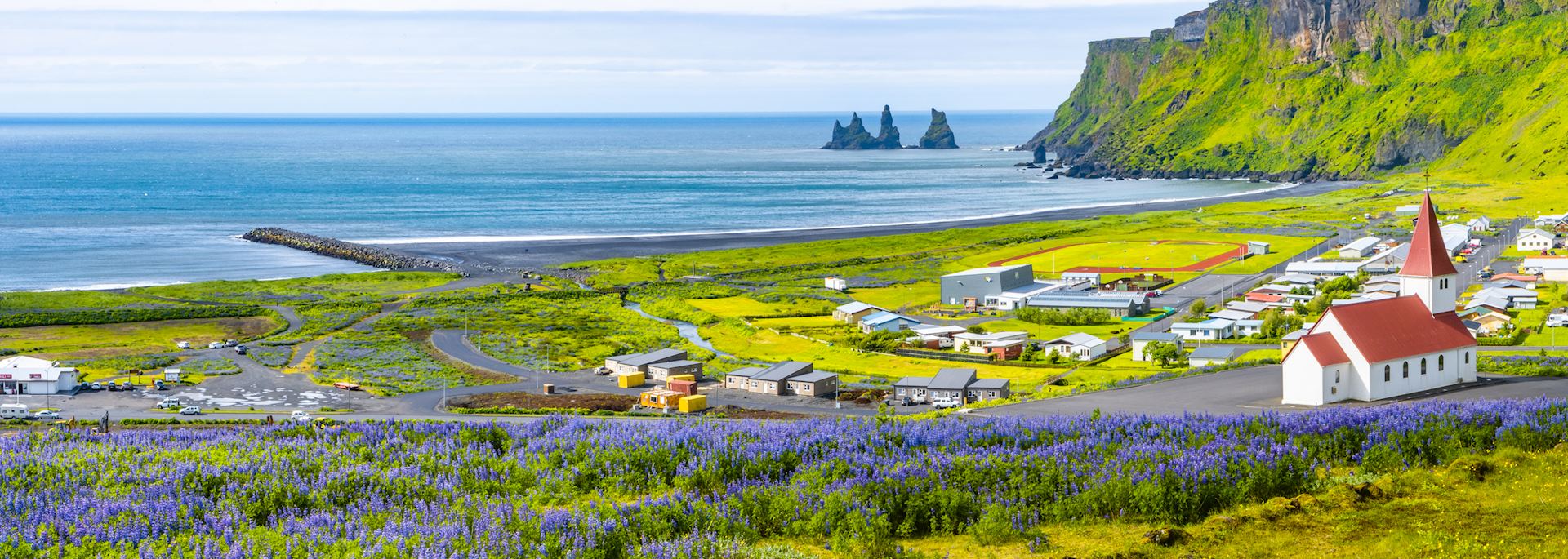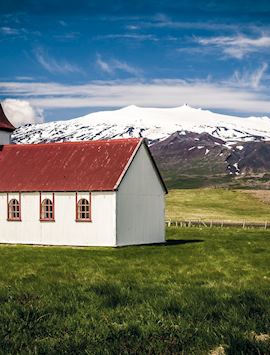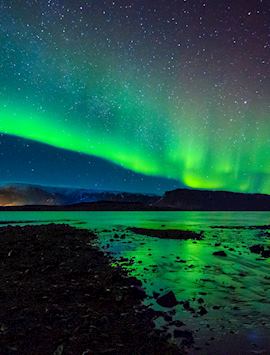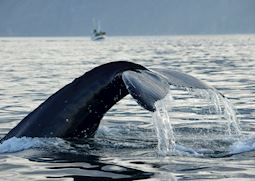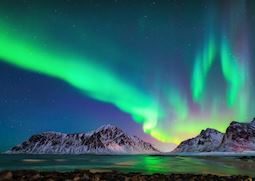The best time to visit Iceland depends on what activities you’d like to do, as some of them are seasonal. For example, you can only explore inland by 4x4 from July, once the snow in the highlands has thawed. Those who hope to see the northern lights should visit between November and February, when the nights are longest.
However, Iceland is a great year-round destination, enjoying a temperate maritime climate. Summers are short and cool, with temperatures between 9°C and 13°C, while winters are long but surprisingly mild, with highs of 3°C and lows of -2°C.
There can be unexpected rain throughout the year, so you should always be prepared for chilly, wet and windy days. Winter blizzards may delay travel plans, and late thaws in the highlands might affect travel in the summer. But, as Icelanders will say: if you don’t like the weather, just wait a bit.
Month-by-month guide for travelling in Iceland
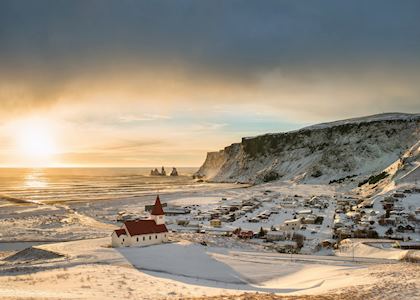
Visiting Iceland in January
The days are short and the nights are long, which improves your chances of seeing the northern lights in the dark, unpolluted skies. Festive lights continue to illuminate towns and cities — a welcome remedy to the wintry darkness. Daytime sightseeing needs to be planned carefully to coincide with the limited hours of sunlight.
Events & Festivals
- The Þorrablót winter festival is celebrated from mid-January to mid-February. Þorrablót is an old pagan festival originally celebrated by Iceland’s early settlers over a thousand years ago. Revived in the 1800s, it brings local people together to eat, drink, dance and sing traditional songs. A Þorrablót menu consists of traditional Icelandic delicacies, including hákarl (fermented shark), smoked lamb and svið (boiled sheep’s head). This is typically accompanied with brennivín — a schnapps made from potato and caraway. During this time, many restaurants will offer these dishes on their menus.
- The northern lights can be viewed in Iceland between early September and early April, if skies are clear and aurora activity is forecast. Chances of seeing them are best between November and February, when the sun sets before 6pm and the nights are longest.
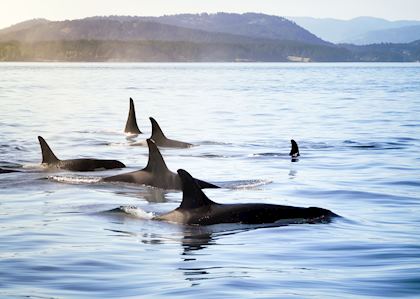
Visiting Iceland in February
The days grow longer at a surprisingly rapid pace, which gives you more time for sightseeing and makes it easier to travel farther into the Icelandic countryside. At this time of year, you can take trips to see orca in the waters surrounding the Snæfellsnes Peninsula, and there are still good opportunities to witness the northern lights strobing across the sky.
Events & Festivals
- The Þorrablót winter festival is celebrated from mid-January to mid-February. Þorrablót is an old pagan festival originally celebrated by Iceland’s early settlers over a thousand years ago. Revived in the 1800s, it brings local people together to eat, drink, dance and sing traditional songs. A Þorrablót menu consists of traditional Icelandic delicacies, including hákarl (fermented shark), smoked lamb and svið (boiled sheep’s head). This is typically accompanied with brennivín — a schnapps made from potato and caraway. During this time, many restaurants will offer these dishes on their menus.
- The northern lights can be viewed in Iceland between early September and early April, if skies are clear and aurora activity is forecast. Chances of seeing them are best between November and February, when the sun sets before 6pm and the nights are longest.
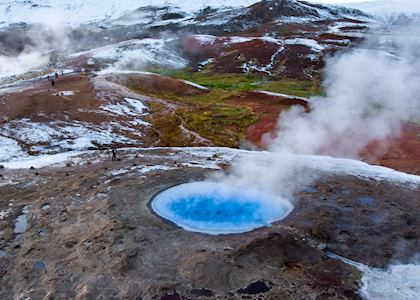
Visiting Iceland in March
The Spring Equinox officially marks the end of winter in Iceland, when daytime lasts as long as night-time. This means you can spend longer each day exploring Iceland’s geothermal landscapes and natural landmarks. There’s still a chill in the air, and winter activities such as ice caving are still popular. Although the nights are shorter, it’s still possible to see the aurora borealis late in the evenings.
Events & Festivals
- The northern lights can be viewed in Iceland between early September and early April, if skies are clear and aurora activity is forecast. Chances of seeing them are best between November and February, when the sun sets before 6pm and the nights are longest.
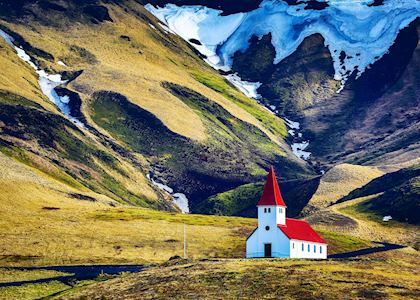
Visiting Iceland in April
April is one of the quieter times to travel, so you’re better able to enjoy sights away from the crowds. Although the Icelandic summer has officially begun, it might not feel like it — rain and snow are still common and lots of summer activities, including puffin viewing, cycling tours and many boat trips, are not yet in operation. As the snow begins to clear, the grassy landscape turns pale yellow.
Events & Festivals
- The northern lights can be viewed in Iceland between early September and early April, if skies are clear and aurora activity is forecast. Chances of seeing them are best between November and February, when the sun sets before 6pm and the nights are longest.
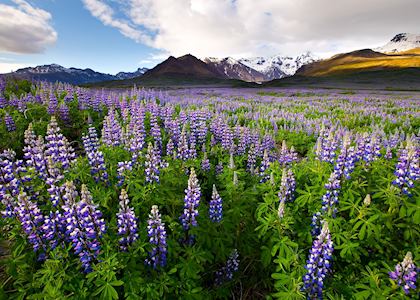
Visiting Iceland in May
The summer season officially begins, with temperatures becoming milder and more activities opening up throughout the country. The main road around the island — sections of which are often closed during winter storms — is usually fully accessible. Seabirds, including puffins, return to Iceland and you can see them nesting in large numbers on the rugged coastline. Toward the end of the month, lambs seem to be everywhere you look and lupine flowers bloom lilac across the countryside.
Events & Festivals
- From mid-May until mid-July, Iceland basks in 24 hours of daylight. The sun dips below the horizon at midnight and rises again at 3am, and it’s never truly dark between these hours. Instead, a pinkish twilight lingers in the sky.
- Kirkjubæjarklaustur Chamber Music Festival takes place in the summer (month varies) in southern Iceland, on a magnificent lava-field landscape.
- The Reykjavík Arts Festival takes place for three weeks each year in May or June. This is a major event in the capital that invites hundreds of artists from around the world to showcase their work.
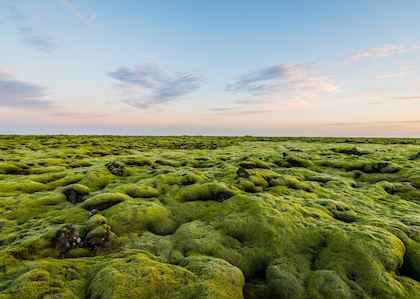
Visiting Iceland in June
The summer solstice marks the longest day of the year, bringing 24 hours of daylight to Iceland as the sun barely dips below the horizon. By now, the landscape is a vivid green, which contrasts sharply with the country’s dark volcanic rock, making for some excellent photography opportunities. Some activities, including quad biking tours and whale watching, take advantage of the midnight sun and are available late into the evening. Plenty of festivals take place in the summer throughout the country, celebrating local arts, food and culture.
Events & Festivals
- From mid-May until mid-July, Iceland basks in 24 hours of daylight. The sun dips below the horizon at midnight and rises again at 3am, and it’s never truly dark between these hours. Instead, a pinkish twilight lingers in the sky.
- Humarhátið festival takes place in late June or early July in the little town of Höfn, in southeast Iceland. Focused on local seafood, this is a great opportunity to try freshly caught Icelandic langoustine.
- Kirkjubæjarklaustur Chamber Music Festival takes place in the summer (month varies) in southern Iceland, on a magnificent lava-field landscape.
- The Reykjavík Arts Festival takes place for three weeks each year in May or June. This is a major event in the capital that invites hundreds of artists from around the world to showcase their work.
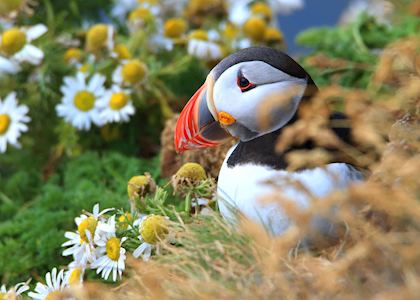
Visiting Iceland in July
Snow in the highlands has thawed and roads through Iceland’s wild interior are now accessible, offering opportunities to explore inland by 4x4. One of the most popular times to travel, visitors come to experience the midnight sun and Iceland’s vast array of outdoor activities. You can expect larger crowds at major attractions such as the Golden Circle, Lake Mývatn and along the south coast.
Events & Festivals
- From mid-May until mid-July, Iceland basks in 24 hours of daylight. The sun dips below the horizon at midnight and rises again at 3am, and it’s never truly dark between these hours. Instead, a pinkish twilight lingers in the sky.
- Humarhátið festival takes place in late June or early July in the little town of Höfn, in southeast Iceland. Focused on local seafood, this is a great opportunity to try freshly caught Icelandic langoustine.
- Kirkjubæjarklaustur Chamber Music Festival takes place in the summer (month varies) in southern Iceland, on a magnificent lava-field landscape.
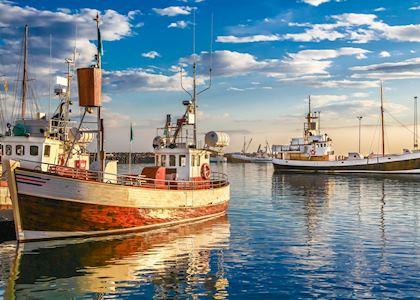
Visiting Iceland in August
The weather is mild and rainfall remains comparatively low. Visitors to Iceland reach their peak, so hotels should be booked well in advance and you can expect the country’s well-known landmarks and attractions to be busy. Many seabirds begin their migration south from the middle of August, so plan your travel at the beginning of the month if you’d like to see them.
Events & Festivals
- Fiskidagurinn Mikli (Great Fish Day) takes place on the first or second Saturday of August in the fishing village of Dalvík, in north Iceland. This is a big social event, with outdoor seafood buffets, and free fish soup offered in locals’ homes.
- Síldarævintýri (Herring Adventure Music Festival) is hosted in the town of Siglufjörður, in north Iceland, over the early August public holiday. In the past, the festival has featured a broad range of Icelandic music, from folk singing to Sigur Rós.
- Menningarnótt (Culture Night) is celebrated in Reykjavík in August. This is a major event, with roads closing for street performers and fireworks in the evening.
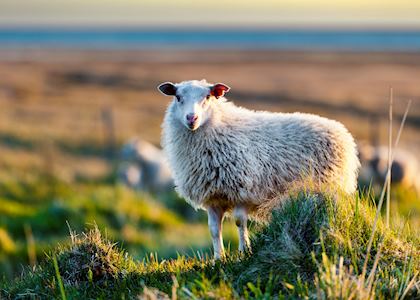
Visiting Iceland in September
As the peak summer season winds down, this is a quieter time to travel in Iceland while the whole island is still generally accessible. September is usually cooler and wetter than July and August, but many summer activities and attractions are still available. As you drive through the countryside, look out for the annual réttur taking place, when farmers round up the 800,000 sheep that have been roaming the land during the summer.
Events & Festivals
- The northern lights can be viewed in Iceland between early September and early April, if skies are clear and aurora activity is forecast. Chances of seeing them are best between November and February, when the sun sets before 6pm and the nights are longest.
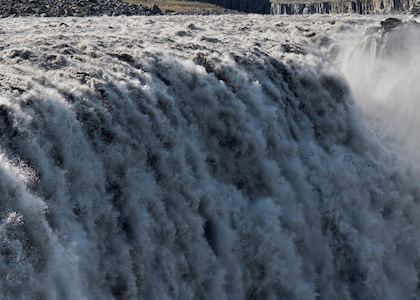
Visiting Iceland in October
October is typically the wettest month in Iceland, but there are noticeably fewer visitors compared to the summer months. Many summer activities are no longer available and adverse weather increases the risk of road closures, so travel is now generally limited to the south coast, north and west Iceland.
Events & Festivals
- The northern lights can be viewed in Iceland between early September and early April, if skies are clear and aurora activity is forecast. Chances of seeing them are best between November and February, when the sun sets before 6pm and the nights are longest.
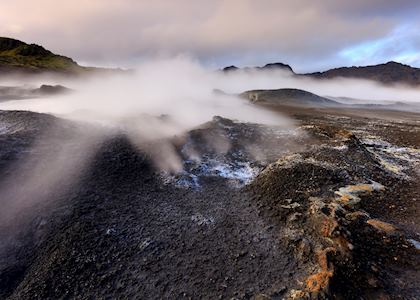
Visiting Iceland in November
As the nights draw in, the northern lights often appear in the sky. Seasonal winter activities, such as ice caving, are also now possible. Temperatures are cool, but there’s still plenty to do to lure you outdoors and the cold air makes the geothermal steam rising from hillsides become more pronounced.
Events & Festivals
- The northern lights can be viewed in Iceland between early September and early April, if skies are clear and aurora activity is forecast. Chances of seeing them are best between November and February, when the sun sets before 6pm and the nights are longest.
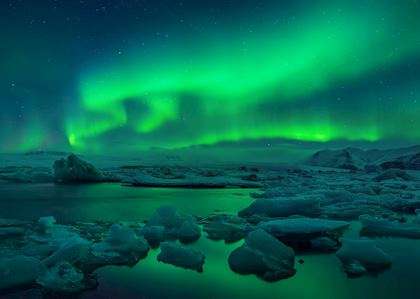
Visiting Iceland in December
A wonderful time to visit Iceland, when festive lights illuminate towns and cities. Toward the end of the month, the sun lingers on the horizon for just four hours, creating a strange, ethereal twilight. Tours need to be planned carefully to make the most of the limited daylight hours, and, weather permitting, the northern lights frequently make an appearance.
Events & Festivals
- In the 13 days before Christmas, troll-like Jólasveinar (‘Yule lads’) are said to visit children one-by-one in the days leading up to Christmas. Formerly, they tried to play tricks on people, but now they leave children small gifts. You might see the Jólasveinar projected onto buildings in Reykjavík, and they visit some hotels to leave small tokens for guests.
- New Year’s Eve is the biggest party of the year in Iceland, when bonfires and fireworks are lit, and Icelanders gather to share the warmth and sing. Belief in elves (huldufólk) is widespread in Iceland and they’re said to be most active at New Year, so it’s common for Icelanders to reference them in songs at this time of year.
- The northern lights can be viewed in Iceland between early September and early April, if skies are clear and aurora activity is forecast. Chances of seeing them are best between November and February, when the sun sets before 6pm and the nights are longest.
Iceland Climate Guide
| Destination | Jan | Feb | Mar | Apr | May | Jun | Jul | Aug | Sep | Oct | Nov | Dec |
|---|---|---|---|---|---|---|---|---|---|---|---|---|
| Blue Lagoon | 2°C 104mm | 3°C 101mm | 3°C 102mm | 5°C 82mm | 9°C 68mm | 11°C 71mm | 13°C 67mm | 13°C 92mm | 10°C 97mm | 7°C 124mm | 3°C 104mm | 2°C 111mm |
| Dettifoss | -2°C 68mm | -1°C 52mm | -1°C 58mm | 2°C 45mm | 6°C 38mm | 10°C 50mm | 12°C 61mm | 11°C 66mm | 7°C 71mm | 3°C 82mm | 0°C 71mm | -1°C 69mm |
| Eastfjords | 1°C 101mm | 2°C 71mm | 1°C 81mm | 3°C 49mm | 6°C 47mm | 9°C 48mm | 11°C 58mm | 11°C 66mm | 8°C 93mm | 6°C 107mm | 3°C 83mm | 2°C 88mm |
| Flatey | -1°C 87mm | -1°C 77mm | -1°C 77mm | 2°C 57mm | 6°C 42mm | 9°C 47mm | 11°C 51mm | 10°C 60mm | 7°C 78mm | 3°C 102mm | 0°C 96mm | -1°C 83mm |
| Golden Circle | 0°C 93mm | 0°C 92mm | 1°C 92mm | 4°C 77mm | 8°C 60mm | 11°C 76mm | 13°C 79mm | 12°C 92mm | 9°C 91mm | 5°C 111mm | 1°C 97mm | 0°C 99mm |
| ¸é±ð²â°ìÂá²¹±¹Ã°ì | 1°C 99mm | 2°C 97mm | 2°C 99mm | 5°C 75mm | 9°C 60mm | 11°C 67mm | 13°C 66mm | 12°C 83mm | 9°C 86mm | 6°C 115mm | 2°C 97mm | 1°C 100mm |
| Snæfellsnes Peninsula | 0°C 87mm | 0°C 85mm | 0°C 84mm | 3°C 67mm | 7°C 49mm | 10°C 55mm | 12°C 57mm | 11°C 68mm | 8°C 78mm | 5°C 103mm | 1°C 94mm | 0°C 90mm |
| Troll Peninsula | -2°C 64mm | -1°C 52mm | -1°C 59mm | 2°C 46mm | 6°C 33mm | 10°C 43mm | 11°C 54mm | 11°C 60mm | 7°C 62mm | 3°C 73mm | 0°C 62mm | -1°C 65mm |
| Vatnajökull National Park | -2°C 174mm | -1°C 148mm | -1°C 147mm | 2°C 123mm | 5°C 122mm | 9°C 130mm | 11°C 122mm | 10°C 152mm | 7°C 153mm | 3°C 199mm | -1°C 159mm | -2°C 164mm |
Why travel with Audley?
- 100% tailor-made tours
- Fully protected travel
- Established for over 25 years
- 98% of our clients would recommend us
Travel advice
Practical tips for travelling to Iceland, from social protocols to guidance on money matters, with a link to the latest FCDO travel advice.

Request our brochure
Covering all seven continents, The World Your Way shows you how you can see the world with us. It features trip ideas from our specialists alongside hand-picked stays and experiences, and introduces our approach to creating meaningful travel experiences.
Trip ideas and travel guides for exploring Iceland
-
![Snæfellsnes Peninsula]()
-
![Northern lights]()
-
Highlights of Iceland: volcanoes, glaciers, whales and waterfalls ![Humpback whale]()
Highlights of Iceland: volcanoes, glaciers, whales and waterfalls
Highlights of Iceland: volcanoes, glaciers, whales and waterfalls
Read this guide -
Seeing the northern lights in Iceland: a Q&A ![Northern lights in Iceland]()
Seeing the northern lights in Iceland: a Q&A
Seeing the northern lights in Iceland: a Q&A
Read this guide
